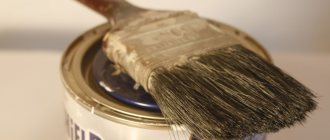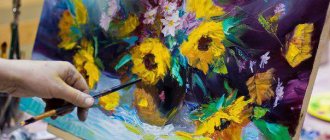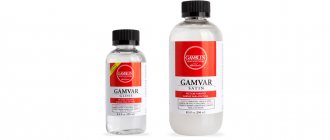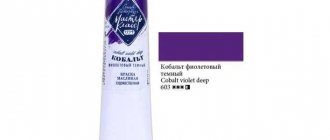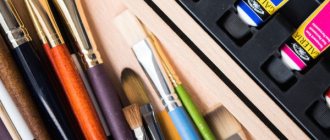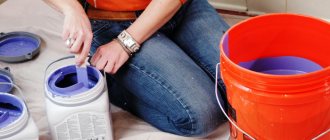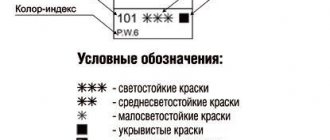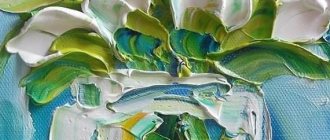All novice artists know that a brush is the artist’s main tool. But not everyone follows the rules when going to the store to make a purchase. But to choose brushes for oil painting, you need to know some rules and be able to distinguish a good brush from a bad one. How to do this, read my article.
The very first brushes appeared long before painting, in the usual sense for us. Three thousand years ago, in Ancient China, rich and educated people invented a device for writing hieroglyphs. But, unlike modern brushes, their bristles were completely different - the very first brushes were made from the hair of a fox, cat, or rat.
Today, humanity has come a long way, and in order to understand what kind of brushes novice artists need for oil paints, let's look at a few basic characteristics - material, shape and length of the handle. Based on these three criteria, I advise you to choose your first painting brushes.
Material
All creative people, and especially artists, understand how important the quality of materials is. The quality of the brush directly depends on what material it was made from. Artists use different brushes to work with oil, but let's focus on the most basic ones.
Squirrel
A soft brush with black bristles, used in watercolor painting. But for oil painting, I would not recommend choosing a brush made of squirrel wool, since caustic thinners during cleaning can easily ruin its delicate and soft bristles, leaving only a few fibers on the brush.
Columns
Light, slightly reddish, brushes made from kolinsky wool also have soft, but stiffer bristles compared to squirrel wool. This brush is ideal for painting with gouache or acrylic.
Pony
Another type of brush made from natural bristles, but not as popular as squirrel or kolinka brushes. Often, such brushes are bought for children for art lessons at school - they can not only paint, but also perform a number of decorative and applied works, for example, when working with PVA glue.
Bristle
A stiff, white pig bristle brush holds the shape of the bristles perfectly, and even over time does not wear off as much as previous brushes. Bristle brushes are some of the best oil brushes. They hold thick oil paint quite well, and are also very convenient for applying voluminous strokes, giving an interesting texture to the picture.
Synthetics
Perhaps one of the most versatile options is synthetic bristle brushes. These brushes are ideal for both oil paints and acrylic, gouache, and tempera paints.
They have soft, fairly elastic bristles, hold the tip well, and easily tolerate various chemical thinners, varnishes and other oil painting products.
In addition, artificial brushes are much easier to wash, the bristles do not fall out, and they are cheaper than natural squirrels and columns.
A little advice for beginning artists and painting lovers
You can buy many brushes at once and test them in your work... Each artist has his own favorite brushes, and you will have them too. We test, check, fall in love, leave! Usually, the best works are created according to this principle.
Or buy the main arsenal for an artist, test it too and fall in love!
A flat brush - bristles No. 5-7 - can be used to make rectangular strokes, as well as give the image a rich color.
Round bristle brush No. 8-10 - this accessory is convenient for starting to draw a composition, as well as for making long strokes with relief.
A short flat synthetic brush No. 2 with a rounded tip, as well as a kolinsky brush (No. 1-2-3-4) easily works on fine details.
And now the “little secret” of working with oil paints
Very often paint leaks under the metal bushing of the brush, which is very difficult to get rid of. A new brush should be dipped in sunflower oil and left upside down for a day.
This way, you will ensure that paint does not penetrate deep into the tool. In this case, the brush will last much longer than usual.
Friends and lovers of oil painting, using a sufficient assortment of brushes, you can create amazing and unique paintings using the Impasto (relief painting), Alla prima Dry brush technique .
But no matter what technique you use to paint your paintings, it is important to remember that the length, direction and saturation of the paint mask determine the movement of your wrist and fingers, as well as the force of pressure of the brush with paint on the canvas.
By the way, why do they say that paintings are written and not drawn ? Ever thought about this? Find out how to use this terminology correctly right now
And now a small conclusion: A brush is just a tool that helps to reproduce a plot on a canvas or other surface, but your hand always remains the main “master” of this tool.
You can paint pictures not only with brushes, but also with your fingers, rags, crumpled paper and even some parts of the body
So let your hand create fabulous scenes and colorful motifs! Draw, write and always remain creative!
Also read about the Development of modern painting with examples and philosophical discussions on this topic! Look at art from a different perspective!
Friends, support the article, leave a comment, share with your friends on social networks on the left side. Video reflection: how artistic taste is formed, what influences its formation
Friends, so that the article does not get lost among many other articles on the Internet, save it in your bookmarks.
This way you can return to reading at any time.
Ask your questions below in the comments, I usually answer all questions quickly
Form
The basic shape of brushes most common among artists is round and flat.
Make a large, sweeping stroke, or draw the thinnest line - all this can be done with a round . Applying oil with such a brush is very convenient, especially if you want to work on some fragment in the picture in more detail.
A flat brush is perfect for filling and covering large areas of the canvas with paint. A wide flat brush made of synthetic bristles can also be used when covering a painting with varnish. Moreover, it is not necessary to buy an expensive artistic brush for this; a simple cheap brush from a hardware store will be enough.
As you may have guessed, the list of brush shapes does not end there, because artists are inventive people and have come up with brushes for different occasions.
For example, brushes with an angled tip will help you create a perfect, even line, as will a liner brush, a very thin, elongated brush that looks like an eyeliner brush. oval- brush , like a cross between flat and round, combines several qualities at once. And if you need to blend the paint, use a fan brush.
There is another type of brush - the flute brush. Flat and wide, the flute brush is usually made of bristles or synthetic, perfect for volumetric work on large canvases, as well as for varnishing the finished work.
Selection of brushes for working with oil paints
It's worth starting by identifying all the processes you'll encounter when painting surfaces. If your task is to paint a large area of the floor with oil paint, it is better to choose wide brushes that will absorb a large amount of paint, which will ensure its uniform application.
If you work with small high-precision objects, you will need to expand your arsenal of tools with flute brushes of various widths and shapes.
Some recommendations when choosing a brush:
- For work with an unprepared surface, it is better to opt for inexpensive brushes, since untreated wood, metal, and concrete will lead to the loss of a fairly large amount of bristles. Even the best quality brushes will be subject to abrasion and the bristles being pulled out by wood fibers.
- The brush should fit well in your hand and be a comfortable size. If you feel uncomfortable when working with a brush, it is better to refuse to use products of this brand in the future. A professional painter-plasterer can process more than 30 square meters in one work shift. area and make several hundred thousand strokes. An inconvenient brush will lead to fatigue in the technician, decreased performance, and the appearance of calluses or sprains.
- Before choosing a brush, check how well the bristles are fixed. Oil paints, as a rule, have a thicker, more viscous composition. Work is often carried out on complex surfaces such as wood, concrete, metal. It is important that the hairs do not fall out, do not break, are elastic, but at the same time strong.
- When working with liquid and super-liquid paints, it is better to use brushes whose bristles have split ends. This will help cover a larger area in one pass, given the increased paint absorption ability of the brush.
- Too long bristles are not suitable for most painting jobs; use medium or short bristles.
- It is better to choose brushes with cone-shaped bristles (thicker at the base and with short tips). In the future, during work, each bristle will be erased from the end and will not lose its properties. A quality oil paint brush can last up to several years with proper care.
A quality brush for oil paints can last a long time if properly cared for.
Handle length
As you have already seen, painting brushes come in completely different shapes, types, and each has its own purpose. But I am often asked that even if the brushes have the same shape and bristles, they differ in the length of their handle. So what is the difference, and what length of brush should a beginning artist choose?
Firstly, let’s decide, just like with the bristles, what should the handle of the brush be made of? Good brushes for oil painting should have a wooden handle. Wood, unlike plastic, is a more practical material, and again, it will not dissolve or deteriorate under the influence of chemical solvents.
Secondly, I would advise any artist who paints in oil or any other paints to buy several brushes of different sizes. This is necessary in order to understand which brush is most convenient and comfortable for you to work with. After all, spending several hours, or even more, at the easel, it will be difficult for you not to get tired, even if you are doing what you love - oil painting.
Therefore, feel free to choose short, medium and long brushes and try to apply the first strokes on the canvas with them.
Summary
As a summary, it’s worth writing about one simple trick that will be useful to every oil painter.
When we paint with oil paint, it is always noticeable how it flows under the metal bushing of the brush, and it is simply impossible to wash it out from there. To avoid this, a new brush must first be dipped in sunflower or linseed oil, pulled out and placed upside down for a day. This time is enough for the oil to be absorbed. The next day you can wash the brush, but the oil will still remain in the roots and will no longer allow the paint to penetrate deeper. This way, your oil painting brush lasts much longer!
tools for beginnersoil paints
Size
You've probably noticed that on each brush, on the handle, usually next to the metal tip or the name of the bristles, there is some kind of number. These numbers tell you what size your brush is.
The smallest round brush the thinnest , will be designated No. 00, and then in ascending order. I would like to immediately note the impracticality of such a brush. As a rule, it consists of only a few fibers, so it will wear off very quickly. Therefore, if you want a thin brush that will serve you more than once, but more, choose brush No. 1. The difference between them is small, but the second one will retain its properties longer.
The designation of the size of flat brushes comes from No. 2 and always in even numbers. The thing is that when the round brush No. 1 is flattened and squeezed, it becomes a flat brush No. 2. The two, when squeezed, becomes No. 4 and so on. Therefore, manufacturers decided to introduce such a designation system so as not to get confused themselves and not to mislead artists, especially beginners.
It is important to note that the size of the brushes is indicated in millimeters. So, for example, a round brush No. 3 will be 3 mm in size, and a flat wide flat brush No. 20 will be 2 cm in size.
Preparing and caring for brushes
To make brushes for oil paints, both natural and synthetic bristles are used. This is due to the fact that the components included in the paints are not aggressive towards artificial materials.
Natural bristles are affordable, easy to care for, environmentally friendly, and durable. A number of manufacturers produce brushes with synthetic fibers, which are characterized by wear resistance and a prolonged service life.
For natural and artificial brushes, the rules for care and preparation for use are almost the same:
- Brushes must be cleaned before use. A soap solution and plain water are excellent for this. Even those brushes that you purchase in hardware stores are not ready for use. Grease, dust, mold, and various debris may accumulate on their surface. Just rinse the brush several times in soapy water and dry it well. Moreover, a brush treated in this way becomes more elastic, the bristles are less likely to break, and oil paint is better absorbed.
- While working, try to wet the tip of the tool by 1/3; when working with liquid compounds, by 2/3.
- Before you begin, pay attention to the tip of your tool. There should be no individual hairs sticking out at the tip of the brush; if there are any, do not cut them with scissors and do not burn the bristles with fire. Simply rub the tip of the brush against a clean concrete surface for 2-3 minutes. The bristles will sharpen and become uniform.
- It is correct to store brushes not in jars of water or white spirit. This may damage the instrument. To “preserve” an already used brush using technology, take a rag, moisten it with solvent, and wrap it in a plastic bag. If all work is completed, the brush must be washed in White Spirit, and only after that in warm water with the addition of soap or any detergent. The brush should be wiped dry with a clean cloth and dried.
- Do not use kerosene, gasoline, or acetone as a detergent. They are very harmful to the stubble.
Choosing the right brush for oil paints will not only save a lot of your time and effort, but will also improve the quality of the treated surface. Professional painters treat their tools with great care and can use them for a very long period of time.
What brushes are needed for oil painting: checklist
Now that we have looked at brushes according to several basic criteria - shape, bristle, size and length, it is important to summarize and orient you, but how do you choose the right brush?
Checklist HOW TO CHOOSE A BRUSH:
- Decide what colors you will paint with. For watercolors, brushes with natural, delicate bristles are suitable, while for oil and acrylic, bristle or synthetic brushes are needed.
- According to the shape, take a round and flat brush, as well as a wide, flat flute brush.
- The pen can be of any length, the main thing is that it is comfortable for you to write with such a brush. Here, as with the shape, take several at once - long, short, medium.
Round brushes
These tools are considered universal, as they can be used to create a variety of shapes and achieve interesting effects. They are also notable for the fact that they hold a lot of paint, so the strokes are clear and rich.
Round brushes come in pointed or oval shapes. The first ones are indispensable for writing thin lines, strokes and other small details. They are convenient for inserting individual strokes exactly where they are needed. The latter are useful for modeling the volume of objects and shading. The thickness and length of the stroke can be easily changed without taking your hand off the drawing. With the side you can make wide strokes of different shapes.
Recommended Manufacturers
As in the case of paints, brushes for painting and drawing also have their own TOP manufacturers:
- Da Vinci is a European brand of premium brushes.
- Faber-Castell is the oldest office supply company.
- Pinax is another well-known brand that came to Russia not so long ago, but has already established itself as a manufacturer of excellent quality brushes.
- Escoda is a Spanish brand, quite expensive among others, since each brush is created by hand.
- Malevich is a Russian brand of inexpensive and high-quality brushes.
- Roubloff - good, high-quality brushes, sold in almost every art store
Flat brushes
This is the name given to brushes that have a flat barrel and a straight edge. They are also considered universal because they hold large amounts of paint well and are suitable for pouring, wide strokes with clear contours and a characteristic angled edge.
Flat brushes come in three main forms:
- square - give sharp, as if torn strokes, which is ideal for still lifes and landscapes;
- with rounded corners - give soft, delicate strokes, connected to each other and are suitable for drawing people and animals;
- oval - the strokes seem to rub into each other, the border between them is very soft, so they are good for portraits.
How to check the quality of a brush in a store
When you come to the store to buy a new brush, remember these important rules:
- The pile does not bristle, the hairs do not fall out and lie one to one.
- The base must be firmly attached to the handle and must not dangle under any circumstances.
- The cartridge of the hand must be solid, without a welding seam.
- The wooden handle should be well varnished.
- You should like the brush, be beautiful and cause pleasure, because you will spend more than one hour with it and be sure to write your best works!
Columns
Perhaps this is the best universal brush for any painting, especially oil painting. Such brushes cost a lot, especially large ones, but their quality and long years of service justify all the costs.
Natural bristles, a moderately obedient and elastic brush, a smooth stroke - an ideal tool for those who paint thinly, layer by layer. There is an opinion that if you are going to paint a portrait, there is nothing better than columns.
The lifespan of these brushes depends not only on proper care, but also on the canvas on which the artist is working. Since the pile here is natural, it is washed and shortened depending on the texture of the canvas. If it’s cardboard, then the brush will really last for years, but this won’t happen with linen canvas. Therefore, it is not recommended to use kolinsky for underpainting on works that are too large in area.
